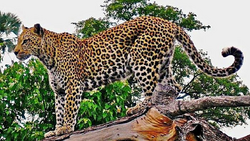| Javan Leopard | |
|---|---|
 | |
| Scientific Classification | |
| Kingdom | Animalia |
| Phylum | Chordata |
| Class | Mammalia |
| Order | Carnivora |
| Family | Felidae |
| Genus | Panthera |
| Species | P. pardus |
| Conservation Status | |
 Endangered | |
The Javan Leopard (Panthera pardus melas) is a subspecies of leopard that lived in Indonesia island of Java.
Characteristics[]
The Javan leopard was initially described as a black panther with dark black spots and silver-grey eyes. It has either a normal spotted coat with rosettes, or a recessive phenotype resulting in a black coat.
Distribution and habitat[]
The Javan leopard is confined to the Indonesian island of Java. It is known to inhabit Gunung Halimun National Park, Ujung Kulon National Park, Gunung Gede Pangrango National Park, Ceremai National Park, Merbabu National Park, Merapi National Park, Bromo Tengger Semeru National Park, Meru Betiri National Park, Ijen Mountain, Baluran National Park, and Alas Purwo National Park. It inhabits altitudes from sea level to 2,540 meters (8,330 feet) ranging from dense tropical rainforest to dry deciduous forests. Outside protected areas, it was recorded secondary forest, mixed agriculture and produced forest between 2008 and 2014.
In the 1990s, it survived in the seral stages of successional vegetation patterns, which made it less susceptible to humans' disruptive activities than many other mammals.
From 2001 and 2004, monitoring research has been conducted in a 20 km² (7.7 sq mi) area of Gunung Halimun National Park using camera traps and radio tracking. Seven leopards were identified in the study area. The total population was estimated at 42 to 58 individuals. The home range of an adult female averaged 9.82 km² (3.79 sq mi).
Ecology and behavior[]
The Javan leopard's prey comprises barking deer, wild boar, Java mouse-deer, crab-eating macaque, silvery lutung, and Javan gibbon. Javan leopards also has been known to look for food in close by villages and prey on domestic dogs, chickens, and goats. Two leopards were radio collared in the Gunung Halimun National Park. Their daily activity pattern showed peaks in the early mornings between 6:00 and 9:00, and late afternoons between 15:00 and 18:00.
Threats[]
The Javan leopard is threatened due to habitat loss, prey depletion, and poaching by human population growth and agricultural expansion. Conflict between local people and leopards is also considered to be a main threat to the Javan leopard. Java has lost more than 90% of its natural vegetation and is one of the most densely populated islands in the world. Primary forests remain only in the mountainous regions at elevations above 1,400 meters (4,600 feet).
Conservation[]
Panthera pardus melas is listed in the CITES Appendix I. Efforts are being made to restore the Javan leopard population and prevent its extinction. Hunting laws are strictly enforced. In 2005, Gunung Halimun National Park was enlarged to three times its original size for the protection of the Javan leopard, the silvery gibbon (Hylobates moloch), and the Javan hawk-eagle (Nisaetus bartelsi).
To address the issue of Java's overpopulation and encroachment on habitat of protected species, the Indonesian government has formed a nationwide family planning program. This program makes contraceptive devices like condoms and several different forms of birth control pills more readily available to the public.
In captivity[]
In 1997, 14 Javan leopards were kept in European zoos. The Javan leopard is not managed in the captive breeding programs in Europe and North America. In 2007, the Taman Safari Zoo in Bogor, Indonesia, kept 17 Javan leopards-seven males and 10 females, of which four were breeding pairs. The Indonesian zoos of Ragunan, Taman Safari, and Surabaya Zoo also keep Javan leopards. As of December 2011, two male and one female Javan leopard were kept in Tierpark Berlin, Germany; and one male and one female in the Jakarta Zoo. In 2013, one male Javan leopard was transferred from Tierpark Berlin to the Prague Zoo.
Evolution[]
According to the morphological research indicates that the Javan leopard is craniometrically distinct from other Asian leopard subspecies, and is a distinct taxon that split off from other Asian leopard subspecies in the Middle Pleistocene about 800,000 years ago. In the Middle Pleistocene, it may have migrated to Java from South Asia across a land bridge that bypassed Sumatra and Borneo.
